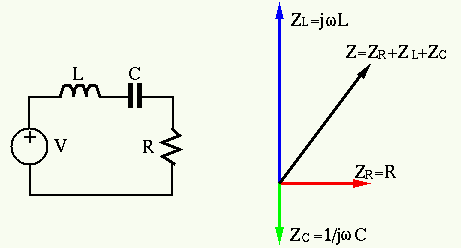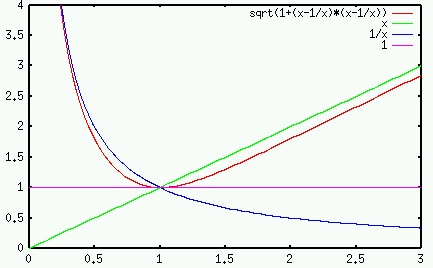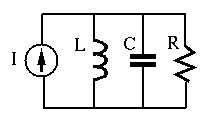If only the steady state response of a second order system is of interest,
then we can ignore the homogeneous solution due to the initial condition
and consider only the particular solution due to the input. To do so, we
convert the 2nd order DE into an algebraic equation in terms of the
impedances of the components. In the following, we consider first the
series system and then the parallel system.
Series system: The overall impedance of the three elements is
 |
(183) |
where
 |
(184) |
 |
(185) |

The impedance
 as a function of frequency
as a function of frequency  is
plotted below:
is
plotted below:

In particular, at the natural frequency
 ,
the impedances of the capacitor and the inductor have the same
magnitude
,
the impedances of the capacitor and the inductor have the same
magnitude
 but opposite phase, and their sum is
zero
but opposite phase, and their sum is
zero  , i.e.,
, i.e.,
 |
(186) |
In this case, the RLC circuit is said to be in resonance, with
the total impedance
 minimized and the current
minimized and the current
 maximized. Also, as the total impedance
has a zero phase angle
maximized. Also, as the total impedance
has a zero phase angle
 , the current
, the current  and
voltage
and
voltage  are in phase. More specially, if
are in phase. More specially, if
 ,
then the total impedance is
,
then the total impedance is
 , i.e., the current
, i.e., the current
 .
.
The quality factor of this series RCL 2nd order system is defined as
Consider the voltages across the three components at
natural when
 :
:
 |
(188) |
 |
(189) |
 |
(190) |
We see that
- The voltage across
 is equal to the source voltage
is equal to the source voltage

- The voltages across
 and
and  have the same magnitude, which
is
have the same magnitude, which
is  times the input voltage
times the input voltage

- The voltage across
 and
and  have opposite phases:
have opposite phases:
 .
.
We see that
 , i.e.,
, i.e.,  and
and  have
opposite polarities and they cancel each other.
have
opposite polarities and they cancel each other.
Example: In a series RLC circuit,  ,
,  and
and
 . The natural frequency
. The natural frequency  can be found to be
can be found to be
 .
The quality factor is
.
The quality factor is
 |
(191) |
or
 |
(192) |
If the input voltage is
 at the natural frequency, the current
is
at the natural frequency, the current
is
 , and the voltages across each of the elements are:
Note that although input voltage is
, and the voltages across each of the elements are:
Note that although input voltage is  , the voltage across L and C (
, the voltage across L and C ( times the input) could be very high, but they are in opposite phase and
therefore cancel each other).
times the input) could be very high, but they are in opposite phase and
therefore cancel each other).
Parallel system:

The overall admittance of the three elements in parallel is
 |
(193) |
where
 |
(194) |
In particular when
 , we have
, we have
 , and the total admittance is minimized
(impedance is maximized):
, and the total admittance is minimized
(impedance is maximized):
 |
(195) |
and the voltage
 is maximized. Also, as
is maximized. Also, as
 , the voltage
, the voltage  and current
and current  are in phase.
are in phase.
The quality factor  of this parallel RCL 2nd order system is
defined as
of this parallel RCL 2nd order system is
defined as
We note that  of the parallel RCL circuit is the reciprocal of
of the parallel RCL circuit is the reciprocal of  of
the series RCL circuit:
of
the series RCL circuit:
 |
(197) |
When
 , the voltage is
, the voltage is
 and the currents through the three components are:
We see that
and the currents through the three components are:
We see that
- The current through
 is equal to the source current:
is equal to the source current:
 ;
;
- The currents through
 and
and  have the same magnitude,
which is
have the same magnitude,
which is  times the input current:
times the input current:

- The currents through
 and
and  have opposite phases:
have opposite phases:
 .
.
We see that
 , i.e.,
, i.e.,  and
and  have
opposite directions, they form a loop current through
have
opposite directions, they form a loop current through  and
and  .
.
The quality factor can also be used to judge whether a second order system
is under, critically or over damped. Qualitatively, a greater  or a smaller
or a smaller
 indicates that the system is energetic, active, and responsive, while
on the other hand, a smaller
indicates that the system is energetic, active, and responsive, while
on the other hand, a smaller  or a greater
or a greater  indicates that the
system is sluggish, inactive, and irresponsive.
indicates that the
system is sluggish, inactive, and irresponsive.
 |
(201) |
The concept of the quality factor  of a second order RCL circuit
can be generalized to describe any second or higher order system,
as the ratio between the energy stored in the system and the energy
dissipated by the system:
of a second order RCL circuit
can be generalized to describe any second or higher order system,
as the ratio between the energy stored in the system and the energy
dissipated by the system:
 |
(202) |
In the case of the series RCL circuit, this is the ratio between
the energy stored in  and
and  (proportional to
(proportional to  and
and
 ) and the energy dissipated by
) and the energy dissipated by  (proportional to
(proportional to
 ) per period
) per period
 at the natural frequency
at the natural frequency
 . Consider the maximum energy stored
in
. Consider the maximum energy stored
in  :
:
 |
(203) |
and the maximum energy stored in  :
:
 |
(204) |
where
 is the peak current through
is the peak current through  , and
, and
 is the peak voltage across
is the peak voltage across  .
.
At the natural frequency
 ,
,
 ,
,
 , and the capacitor and the inductor store the same
amount of energy:
, and the capacitor and the inductor store the same
amount of energy:
 |
(205) |
The energy  is converted back and forth between magnetic
energy in
is converted back and forth between magnetic
energy in  and electrical energy in
and electrical energy in  . The energy dissipated
in
. The energy dissipated
in  per cycle
per cycle
 is:
is:
 |
(206) |
Substituting  and
and  into the definition of the quality
factor, we get
into the definition of the quality
factor, we get
 |
(207) |
which is the same as the  previously defined.
previously defined.
The quality factor  and the damping coefficient
and the damping coefficient  are
inversely related to each other:
are
inversely related to each other:
 and and |
(208) |
The phenomenon of resonance is of great importance in many
physical systems such as mechanical structures and electrical
circuits. One well known example of resonance causing damage
in mechanical structures is the
Broughton_Suspension_Bridge.
On the other hand, resonance plays an important role in tuning
circuits in radio and TV reception, as we will discuss later.











 minimized and the current
minimized and the current
 maximized. Also, as the total impedance
has a zero phase angle
maximized. Also, as the total impedance
has a zero phase angle
 , the current
, the current  and
voltage
and
voltage  are in phase. More specially, if
are in phase. More specially, if
 ,
then the total impedance is
,
then the total impedance is
 , i.e., the current
, i.e., the current
 .
.











 is equal to the source voltage
is equal to the source voltage

 and
and  have the same magnitude, which
is
have the same magnitude, which
is  times the input voltage
times the input voltage

 and
and  have opposite phases:
have opposite phases:
 .
.
 , i.e.,
, i.e.,  and
and  have
opposite polarities and they cancel each other.
have
opposite polarities and they cancel each other.







 at the natural frequency, the current
is
at the natural frequency, the current
is
 , and the voltages across each of the elements are:
, and the voltages across each of the elements are:



 , the voltage across L and C (
, the voltage across L and C ( times the input) could be very high, but they are in opposite phase and
therefore cancel each other).
times the input) could be very high, but they are in opposite phase and
therefore cancel each other).



 , we have
, we have
 , and the total admittance is minimized
(impedance is maximized):
, and the total admittance is minimized
(impedance is maximized):

 is maximized. Also, as
is maximized. Also, as
 , the voltage
, the voltage  and current
and current  are in phase.
are in phase.








 of the parallel RCL circuit is the reciprocal of
of the parallel RCL circuit is the reciprocal of  of
the series RCL circuit:
of
the series RCL circuit:

 , the voltage is
, the voltage is
 and the currents through the three components are:
and the currents through the three components are:



 is equal to the source current:
is equal to the source current:
 ;
;
 and
and  have the same magnitude,
which is
have the same magnitude,
which is  times the input current:
times the input current:

 and
and  have opposite phases:
have opposite phases:
 .
.
 , i.e.,
, i.e.,  and
and  have
opposite directions, they form a loop current through
have
opposite directions, they form a loop current through  and
and  .
.







 and
and  (proportional to
(proportional to  and
and
 ) and the energy dissipated by
) and the energy dissipated by  (proportional to
(proportional to
 ) per period
) per period
 at the natural frequency
at the natural frequency
 . Consider the maximum energy stored
in
. Consider the maximum energy stored
in  :
:

 :
:

 is the peak current through
is the peak current through  , and
, and
 is the peak voltage across
is the peak voltage across  .
.




 is converted back and forth between magnetic
energy in
is converted back and forth between magnetic
energy in  and electrical energy in
and electrical energy in  . The energy dissipated
in
. The energy dissipated
in  per cycle
per cycle
 is:
is:

 and
and  into the definition of the quality
factor, we get
into the definition of the quality
factor, we get

 previously defined.
previously defined.


 and
and